What Kind of Green Beans Should You Grow?
You’re planning your summer garden, and you know you want green beans. You may not know if you want to freeze them, can them, or simply grow enough to eat fresh. You just know you want them. They’re supposed to be one of the easiest crops to grow, so it shouldn’t be that hard, right?
When I began my garden, I chose green beans because everyone else was doing it. It seemed so simple, but I didn’t even know where to start. Specifically, I didn’t know what kind to grow with so many options available!
THAT was the question I had the hardest time finding an answer to.
If you’re planning on growing green beans, here are the two basic questions you’ll need to answer:
- Do you want to grow pole beans or bush beans?
- Which variety of green beans should you plant?
Once you’ve made these decisions, you’ll be well on your way to poking your first seeds in the ground.
Should You Grow Pole Beans or Bush Beans?
You can grow green beans in two ways: up — using some type of vertical support — or in rows.
Pole Beans
Pole beans send out vines (Jack and the Beanstalk finally makes sense to me), where they climb up whatever they can find.
Though my husband built me a green bean trellis (after my shoddy attempt at tying bamboo together in the shape of a tepee collapsed), beans have also found their way up my okra, corn stalks, tomato cages, and even netting meant for peas. If it’s vertical, those babies will find their way up.
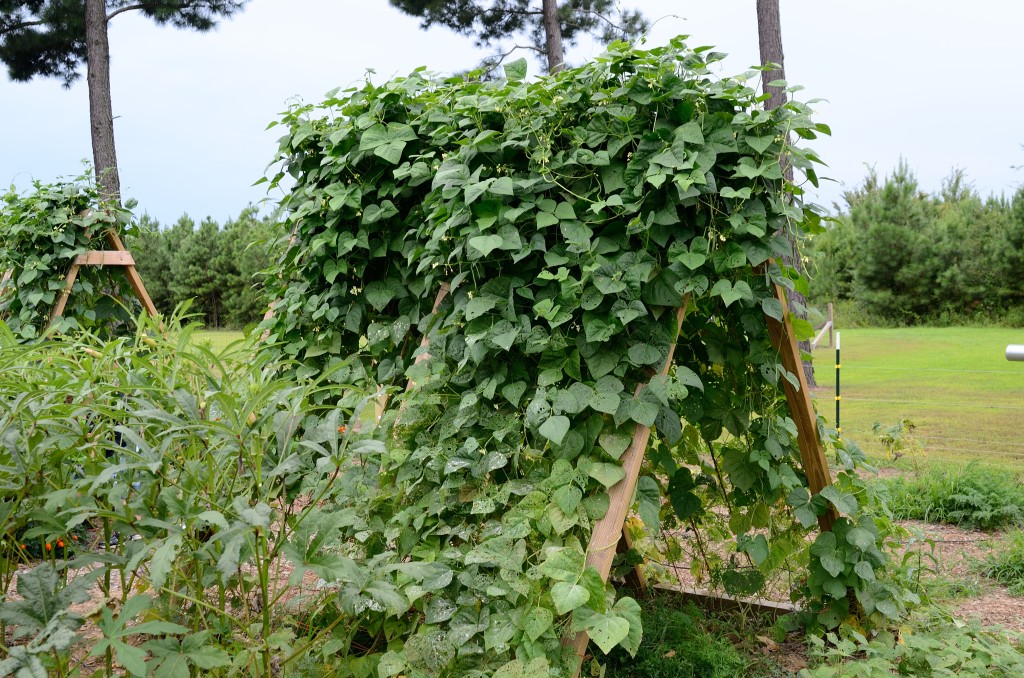
Bush Beans
Bush beans do not send out vines. They produce a small, stocky plant. You plant them in rows and they do not need a trellis.
Difference Between Growing Pole Beans and Bush Beans
Besides their growth habits, pole beans begin producing a couple of weeks later than bush beans, but they produce continually all summer. You will harvest bush beans sooner and all of their beans come on at once. Pole beans tend to produce more beans in quantity than bush beans.
In my experience, pole beans will stop producing in the heat of the summer (and then begin again as the temperatures moderate). But bush beans do not have that problem, possibly because they begin bearing before the heat sets in.
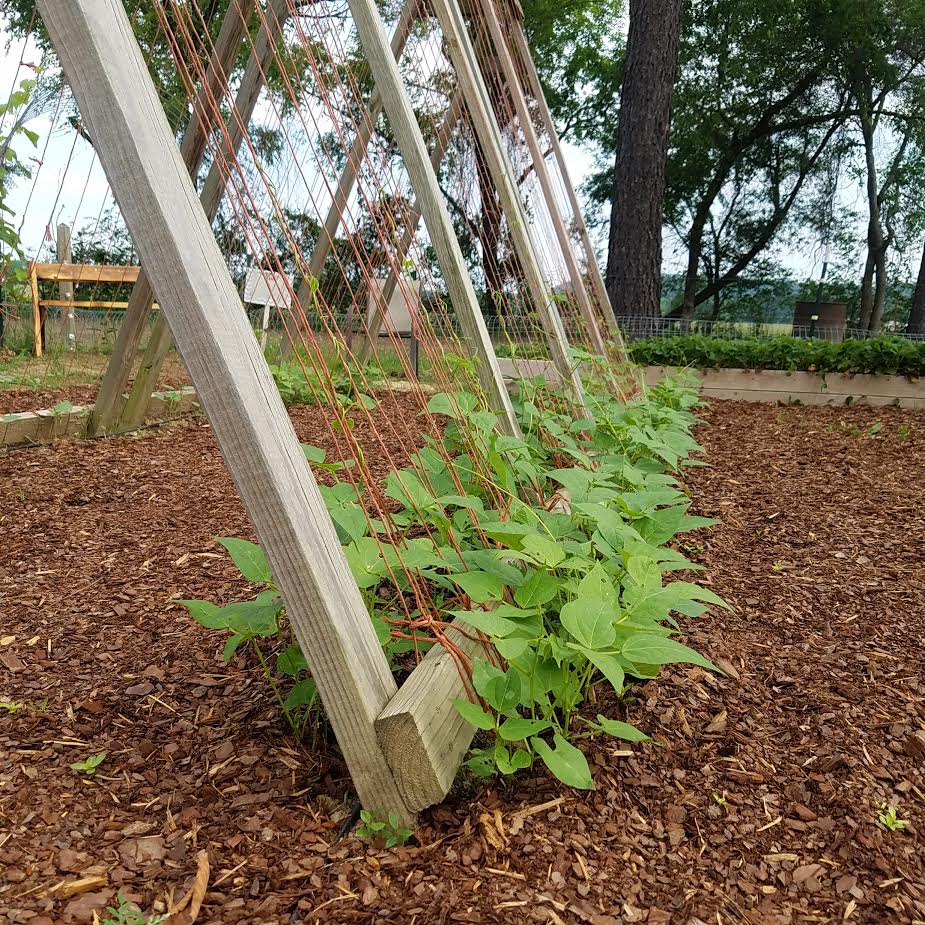
I have grown both, and I prefer pole beans. Not only do they provide a heavy yield, but it’s easier to pick them, with most of them hanging at eye-level or higher. Because they grow up, they take up less garden space.
The advantage bush beans have, besides not needing a vertical support, is their flexibility in succession planting. You can plant, harvest, and pull up, leaving time to plant another crop in its place. They also leave behind less garden waste to clean up. Unless you’re letting pole beans climb up compostable twine (which I have done), they can be more labor-intensive to clean up at the end of the season.

Which Variety of Beans Should You Grow?
Once you decide whether to grow bush or pole beans, you will need to choose a variety. There are countless options to choose from, and you want to grow the best one for your climate.
Personally, I have grown Kentucky Wonder, Blue Lake, Contender, Rattlesnake, Seychelles, Chinese Red Noodle, Purple-podded Pole, and Scarlet Runner.
Kentucky Wonder Green Beans
Kentucky Wonder was my best producer. However, when left on the vine too long, they developed strings, which were tough to eat. I personally gave up growing them because it seemed I never could keep up with harvesting them young enough before they grew tough. But, if you’re looking for a proven variety and you can commit to picking regularly when the beans are young and tender, Kentucky Wonder is an excellent choice.
Blue Lake Pole or Bush Beans
Blue Lake is my go-to green bean, and although I grow the pole variety, the bush Blue Lake is also an excellent producer. In my experience, Blue Lake beans do not produce as heavily as Kentucky Wonder, but their beans are more tender and less quick to develop strings. I also prefer the taste of Blue Lake. They are excellent when picked young.
When growing Blue Lake Pole beans, I have found them finicky when it comes to the heat. Generally, in my southern US climate, I may get a small crop in the early summer, but then they stop producing in July and early August. Then, just when I’m about to give up on them, they produce a bumper crop in late August through mid-October.
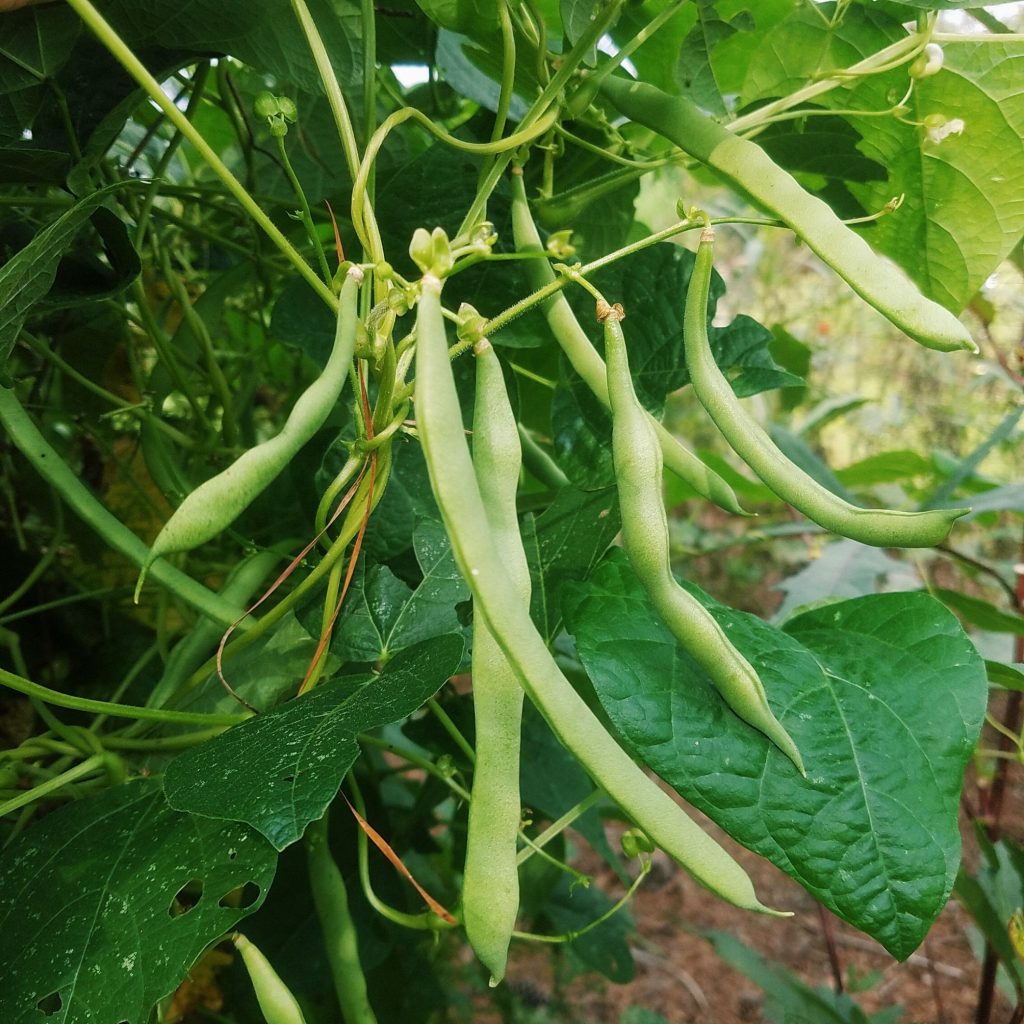
Chinese Red Noodle Beans
After having eyed this beautiful long red bean in seed catalogs for years, I finally tried them for the first time in 2019. In appearance, they were one of my favorite beans to grow. Their large leaves resisted bean beetles better than my other beans, and they produced well in the heat. But my family simply didn’t enjoy the taste — probably because we grow green beans to can, not to eat fresh. But if you enjoy stir-frys and fresh green beans, I highly recommend this variety. Gorgeous and prolific, it’s a great choice.

Contender Green Beans
I only planted Contender as a bush bean, and they were very prolific, long beans that produced a heavy yield. They were a perfect variety for canning, and their bush habit allowed me to pull them up after their harvest to make room for another crop in their place.
Rattlesnake Green Beans
Rattlesnake beans were the prettiest bean I grew with unique markings and purple flowers. They also produced earlier and longer in the heat than Blue Lake beans. My entire family (even the kids!) loved the taste of the Rattlesnake beans, but unfortunately, they didn’t provide as large of a harvest as the Blue Lake in the one year I tried them. I may try them again, though! It’s possible the location I planted them in could have affected their productivity. They were too pretty and too tasty not to give them a second try!
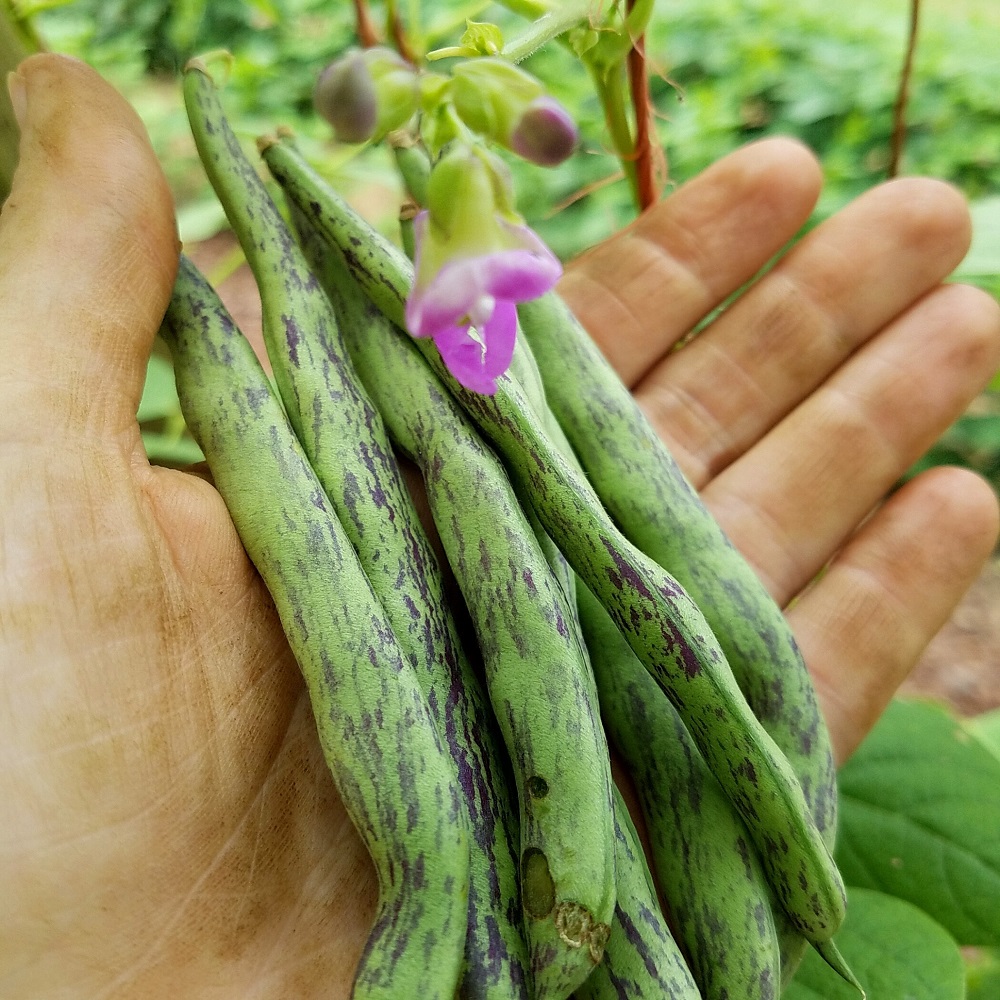
Purple Podded Pole Bean
Who doesn’t love a pop of color in the garden? Especially purple? This purple-podded pole bean was a fun bean to grow, but in my garden, it didn’t produce the yield that the Blue Lake and Red Noodle Beans did (that were planted right beside the purple-podded beans).

Seychelles Green Beans
The Seychelles Green Bean received the coveted All-American Selections winner award in 2017. I had high hopes for it. But it just didn’t produce well in my garden the one year I tried it. However, this is another one with great reviews that I should give another try.
Scarlet Runner Beans
One other option is the beautiful Scarlet Runner Bean. I planted these in the fall since they prefer cooler weather. I only planted them for their striking orange-red flowers, so I don’t have personal experience with eating them. If you want a pole bean to bring beautiful color to your garden in the spring and fall, this easy-to-grow bean would be an excellent addition to your garden.
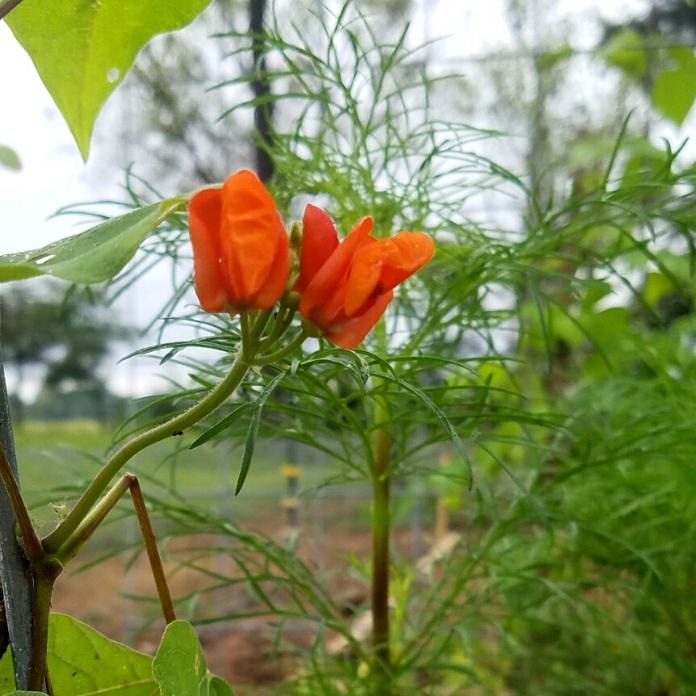
–
Green beans are one of my favorite crops to grow. They require little effort and are much fun to pick. My children usually beat me to the picking! Hopefully these tips will get you on your way to a plentiful green bean harvest as well.
What kind of green bean do you enjoy growing?
Do you get overwhelmed with garden planning?

Subscribe here for my best tips to plan your garden in just 7 days -- all for FREE.
Plus, I'll send you my "In the Garden E-mail" on Fridays, periodic updates on garden resources relevant to you, and you'll receive access to my entire bank of free garden downloads!
You are also agreeing to our privacy policy.

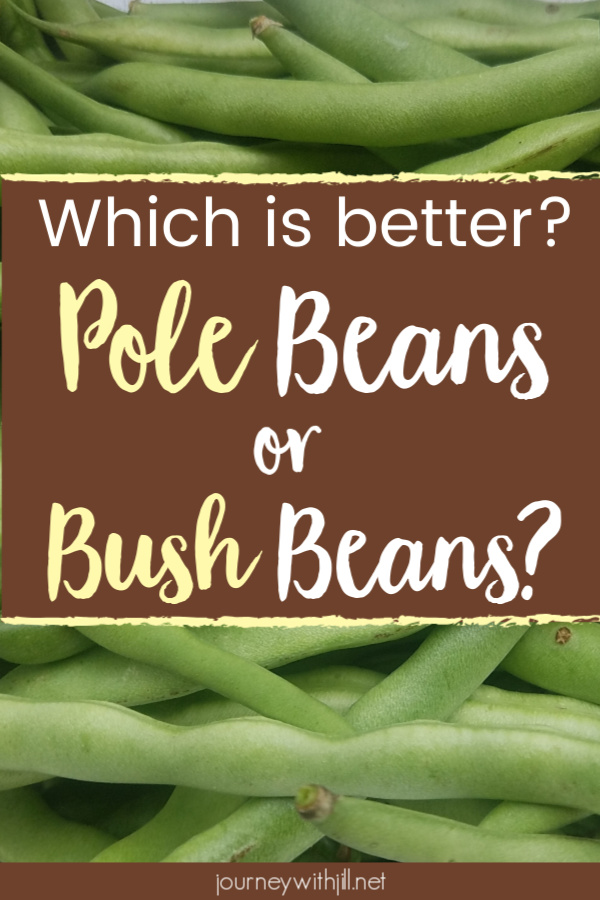
Good site……..live in central austin tx area and HOT now, so wondering WHICH beans!
Most green beans won’t flower and set their pods in the heat of the summer (90+ degrees in my experience). So you can plant them for a late fall harvest (mine start bearing in September), or you can plant asparagus beans (also known as long beans or Chinese noodle beans). Those produced for me all summer last year. They are pole beans. Bush beans, however, you might be able to grow for an early harvest if you get them planted in time. It’s probably too late this year, but again you could look for a late summer/fall crop.
Last year grew fortex, seychelles, and Kentucky wonder next to each other, and the Japanese beetles aimed straight for the first two and left the third relatively alone. Big loss. This year grew Kentucky wonder only and they Resisted JBs fairly well. And they are prolific. But they go to strings way too fast. Next year, thinking blue or Kentucky blue. Worried about JBs though.
Interesting! I haven’t grown Kentucky Wonder in years, but consider the beetle pests on mine (not Japanese, but others), it might be worth revisiting!
Hi
I hope this site is still active. I don’t like the fuzzy or hairy skin on green beans. Do you have any recommendations on which varieties are hairless? I’m open to pole or bush. Thanks!
I’ve never had that on green beans, so I’m not sure if it was a variety or some other kind of issue. But all of the varieties mentioned here, plus Jade (a new favorite bush bean of mine) have been smooth for me.